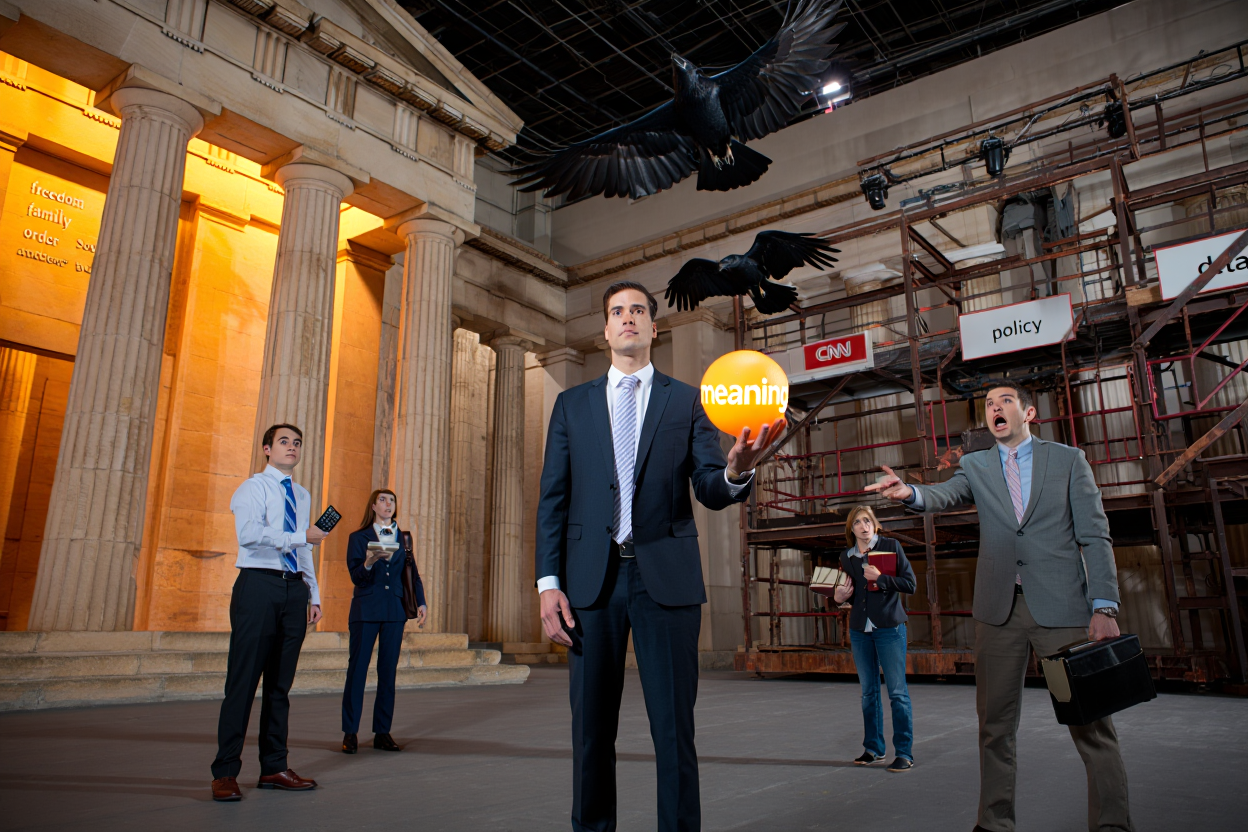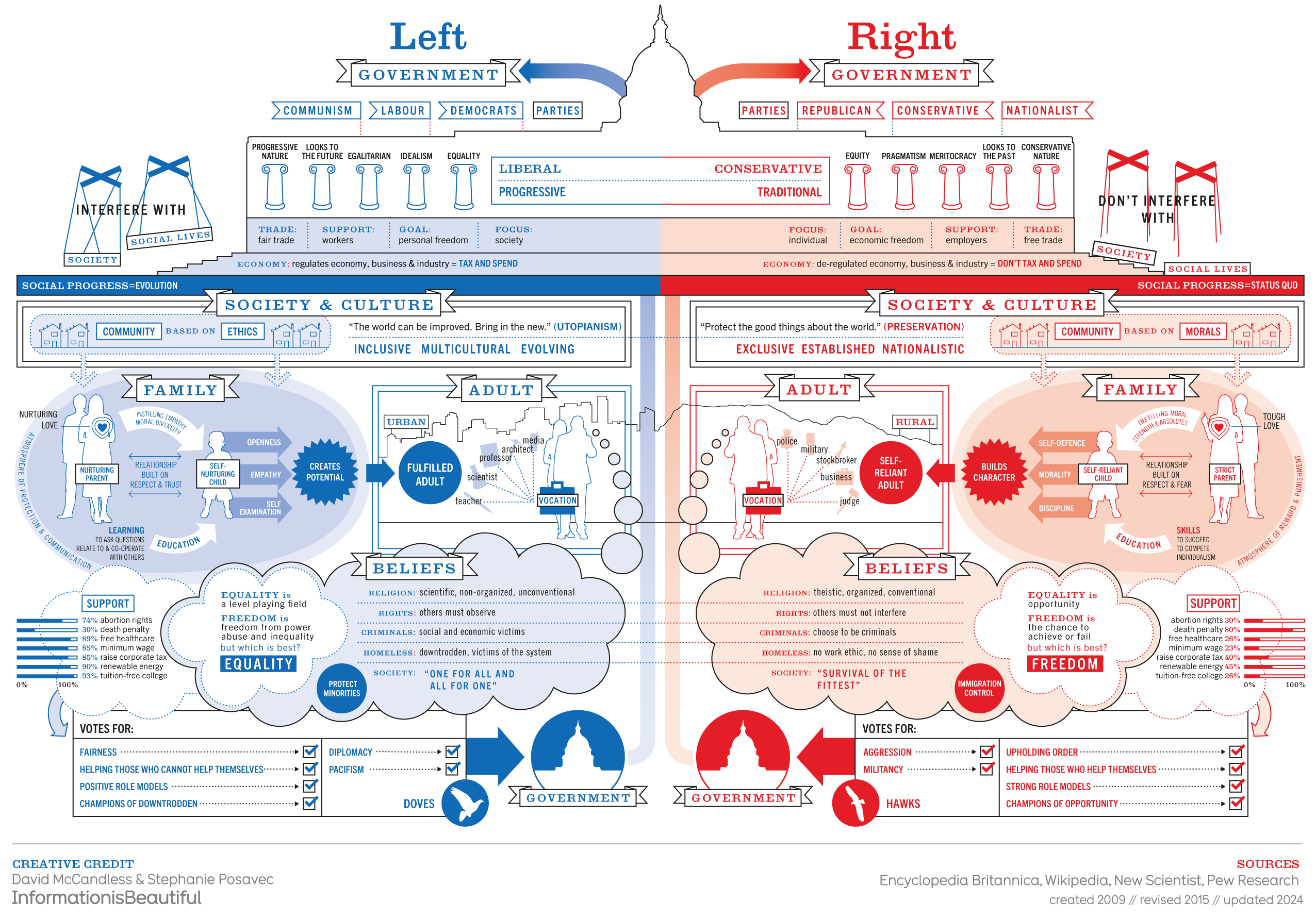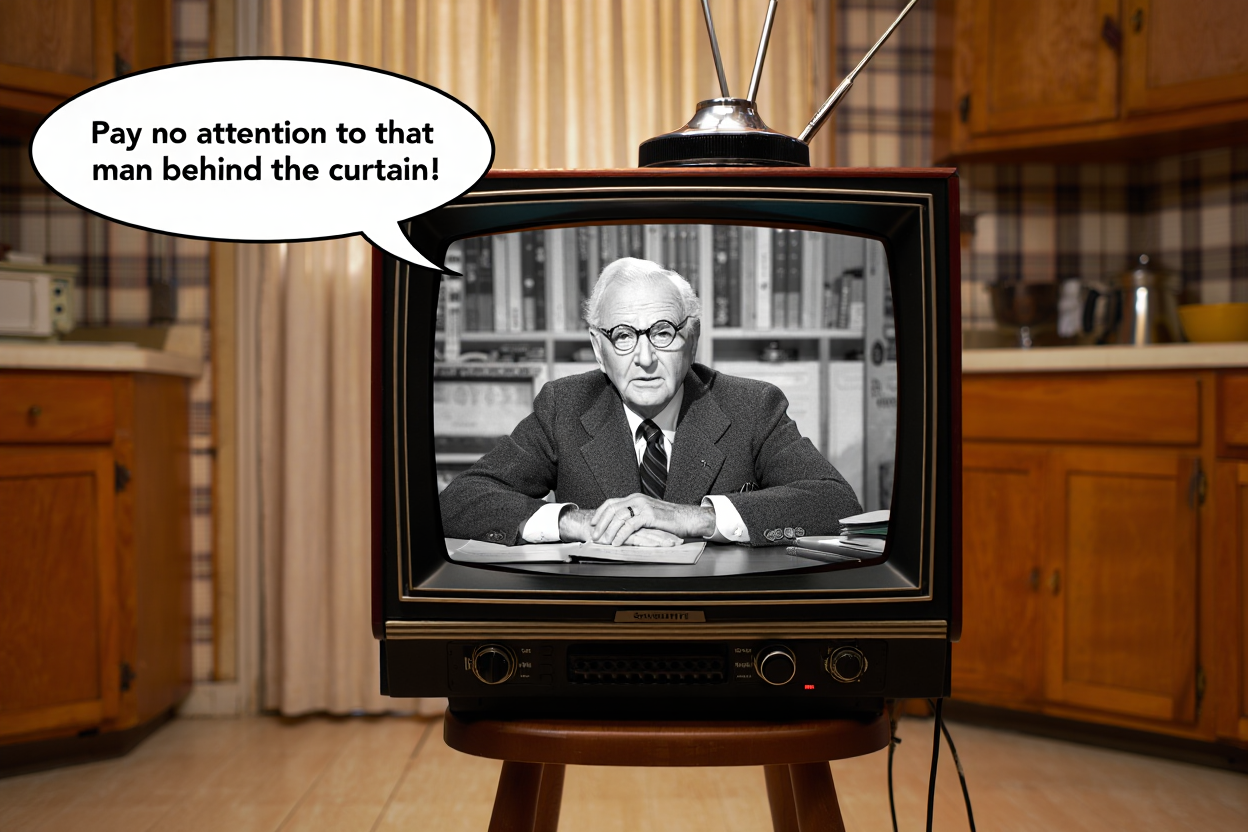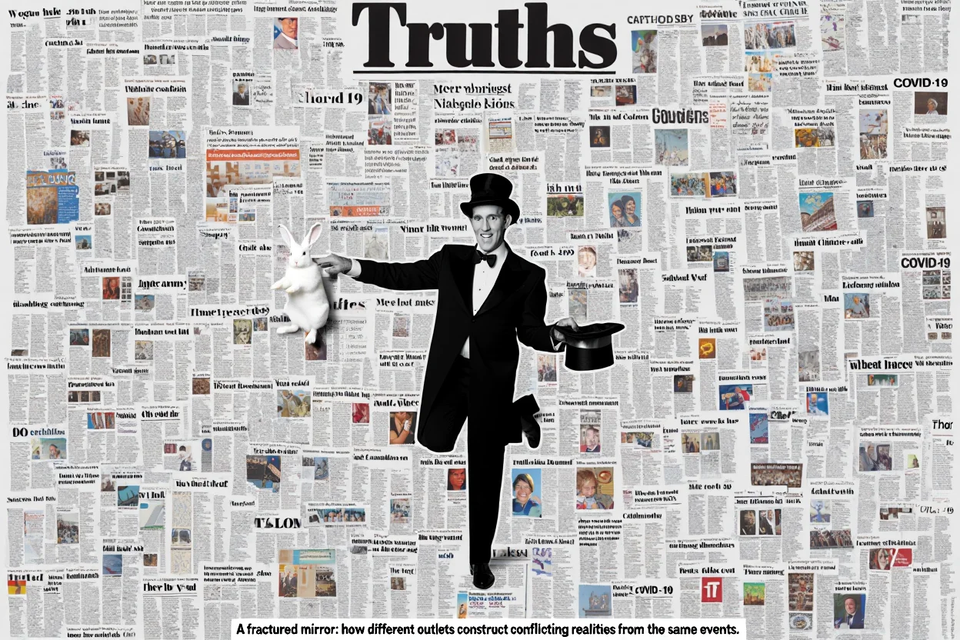Reframing the Frame: Language, Power, and the Battle for Public Meaning
Political power today hinges more on framing than facts. The right uses emotionally charged language to shape meaning, while Democrats and mainstream media often respond with neutral, technocratic rhetoric that lacks resonance. To regain influence, they must reframe, not simply rebut.

Americans today aren’t just divided by facts—they’re divided by the meaning of the same words. A recent study shows that Fox News and CNN often cover the same events, but frame them in radically different ways.

These differences create distinct emotional responses and shape how audiences understand reality. This isn’t merely bias—it signals the rise of separate knowledge communities, where people interpret events through shared language, values, and emotional frames; these groups function as moral tribes, each practicing its own mode of meaning-making.
In this sense, politics has become a clash of linguistic worldviews—a form of divergent communities of practice. It’s a modern incarnation of what Madison warned about in Federalist No. 10. Today, we are confronted with factions not just of interest, but of interpretation and understanding– these political, social and cultural knowledge communities of Americans are divided not only by what they desire, but by how they see and name the world. Through our divergent media discourses, we’ve become trapped in parallel feedback loops of explanation and prediction; these loops no longer intersect, relate, or even acknowledge one another.
This article isn’t about explicitly taking sides between CNN, MSNBC, or Fox News for the purposes of advocating for or advancing a partisan agenda. While I hold strong views about authenticity, fairness, and facts, my deeper concern is how news media shape public understanding.
What’s needed is a realpolitik approach to political journalism in the news that acknowledges power, narrative, and the strategic use of language.
In this light, CNN appears uniquely positioned to pursue a more credible journalistic agenda—not because it’s ideologically pure or above the fray, but because its market position and institutional legacy still allow space for recalibration in the ways that are needed.
CNN's recent production of Good Night, and Good Luck underscores this moment. The brand's enduring legacy and market strength give it both the responsibility and the opportunity to reorient itself toward renewed public trust and more principled public discourse; if it’s willing to act with clarity, conviction, and a genuine commitment to a revised journalistic mission.
This challenge isn’t theoretical. It’s something Mark Thompson, current chairman and CEO of CNN Worldwide (part of Warner Bros. Discovery’s newly spun‑off Global Networks division), has been wrestling with for years. In Enough Said: What's Gone Wrong with the Language of Politics? (2016), written before today’s wave of political fragmentation fully crested, Thompson foresaw what we’re now beginning to confront with urgency: the crisis isn't just one of misinformation—it’s a deeper breakdown in the language of public life.
As I’ve argued, the more profound rupture is a disconnection from any shared sense of American-ness, any common symbolic framework we use to understand ourselves, our institutions, or one another. We no longer disagree over facts alone—we disagree over the meaning of those facts, the stories they fit into, and the moral judgements and conclusions that they imply.
In Enough Said, Thompson traces how public language has become compressed, performative, and reactive; these are qualities that mirror the public’s growing distrust of both media and government. What’s unraveling now isn’t just trust in the press or politics; it’s trust in language itself as a vehicle for truth, identity, and belonging. That collapse isn’t accidental; it’s structural, and it’s been decades in the making.
Language has now been stripped of its connective tissue; semantics, not just syntax, are under assault.
If credible news outlets want to regain public trust and reshape how people understand the world, they must first acknowledge a simple truth: facts alone aren’t enough. Influence depends on framing, emotional resonance, and moral clarity. That shift begins with humility about how meaning is actually constructed and exchanged—and also, how power really operates.

This means grappling with a core dilemma: how to tell their truths in a world that punishes honesty and rewards manipulation. Enlightenment ideals—transparency, rational discourse, good-faith debate—are increasingly mismatched with a media environment saturated by spectacle, outrage, and tribal loyalty. The institutions that still believe in liberal values must stop assuming those values are universally shared. They’re not.
To stay relevant, journalism must adopt a form of principled realism: still committed to truths, but with a recognition of the function of meaning and no longer naive about the battlefield with respect to attribution of meaning with respect to risk and blame in politics.
This means understanding the emotional grammar of propaganda, the moral language of populism, and the strategic logic of power. It means speaking not just to the head, but to the gut—and doing so without abandoning the ethical ground that the profession of journalism is built upon, but doing so with a new type of humility towards the interpretive.
Because in the end, the fight isn’t just over facts. It’s over the frame through which facts acquire meaning as well as the competing beliefs and values those meanings express. Grasping the complexity of interpretation and understanding (over explanation and prediction) is one of journalism’s defining challenges in the 21st century. The good news? Artificial intelligence can help.
News in the public interest must go beyond rebuttal. Fact-checking doesn’t disrupt Fox News. Language does.
To challenge right-wing media dominance, credible news organizations must do more than counter the facts; they need to begin naming things in ways that connect emotionally, fit the culture, and are morally sound. This language should also reach across different beliefs. For example, consider immigration. A credible news organization could use terms like "mixed-status families" or "border futures." This shifts the focus from legality or policy, and these word choices honor human dignity and recognize a very complex and contradictory legal situation.
When it comes to policing, the debate isn't just about “law and order” or “reform", it’s also about ideas like “justice-based protection” and “community safety contracts.” These terms break down false divides. They shift the focus from tribal signaling to shared safety, and they serve to honor the complexity of the moral argument at stake.
The same approach applies to guns. Framing the issue as a “freedom to be safe” shifts the debate—it forces us to distinguish real threats from imagined ones, and it also opens the conversation up for discussions about who needs protecting and from what threat.
By moving the conversation from control versus individual rights to the basic human need/desire for protection, we can talk about “gun responsibility.” This reclaims the language of accountability and personal responsibility without conceding ground on deeply held, constitutionally rooted beliefs and values.

These aren’t semantic tweaks. They are reframes designed to build a new narrative architecture. They absorb emotional logic. Then, they change the language people use to view issues.
Right-wing language succeeds because it encodes values like freedom, strength, family, and order, creating emotional impact and a sense of moral clarity rooted in conservative worldviews, which are opinions that carry moral weight from the perspective of rhetorical should, ought, and must statements– this is personal truth, not universal truth.
In contrast, the left often responds with facts or abstract appeals to justice, but overlooks the emotional structure that gives language power. As C. Wright Mills put it, they’re drunk on syntax, blind to semantics—preoccupied with precision, process, and how things are said, while overlooking how language actually resonates and the deeper meanings words carry. This is the hallmark of technocratic thinking: clarity without emotional traction, communication without narrative power.
Cognitive reframing is the process of shifting how we interpret a situation, issue, or value by changing the underlying assumptions or language used to describe it. It opens space for new conversations by introducing fresh perspectives that resonate emotionally and morally. Without reframing, dialogue stays trapped in the original frame—debates revolve around fixed meanings, reinforcing polarization instead of fostering understanding or new possibilities.
For instance, we can say “Second Amendment responsibility” instead of “gun control.” Use “border stewardship” instead of “enforcement.” Frame healthcare not as “universal coverage,” but as essential “infrastructure for human flourishing.” These shifts trigger less immediate resistance and, they subtly redefine what feels reasonable, gradually reshaping the boundaries of agreement.
Crucially, reframes can't come only from journalists or politicians. They should come from targeted communities; these people could ironically be called traitor messengers: for instance, what if a group of conservative veterans, pastors, sheriffs, and rural mayors could speak openly about the inner moral contradictions? Where are the people who can remain credible with their base but bring in new words from their own experiences?
For example, the words of a veteran carry a distinct kind of authority. If I say publicly, “I support licensing because I’ve carried, issued, and trained others to use firearms in the military– I understand the moral responsibility that comes with them,” it resonates differently than a liberal pundit citing statistics; lived experience speaks where data alone can’t.
What if a coal-town mayor believes, "Resilient futures mean our kids can stay here," and views climate change not as a sacrifice but as a matter of survival and belonging? That may be confusing at first, but these kinds of moral contradictions exist; the moral purity advanced and highlighted by extreme political advocates in the media are mere rhetorical constructions, our inner moral lives are often much messier and less pure.
To change how the right frames issues, these phrases need to be seen where Fox News viewers are. They should show up not just on CNN and MSNBC but also in local op-eds, AM radio, church bulletins, and Facebook groups. Repetition and placement matter.
"Freedom means clean air for your kids." "Faith doesn't mean ignoring the facts." "Law and order start with healthy neighborhoods." These are linguistic Trojan horses. They slip inside the operating system and slowly shift what feels normal to say. None of this works if the news clings to an outdated model of objectivity.
Traditional neutrality assumes that language transmits meaning, clearly– it assumes a matter-of-fact sensibility that people always say what they mean and they mean what they say, but, at the same time, language shapes perception more than it conveys facts. In a fragmented media environment, the facade of objectivity isn't enough. The future of journalism depends on clear framing and being honest about the values that shape reporting is key.
Audiences need moral clarity. They need anchors who acknowledge the messy and contradictory narrative terrain of morals and ethics in America, this begins with not pretending that our disagreement about what should, must, and ought be, does not exist; rebuilding trust isn't about avoiding perspectives, it's about being clear about the moral reasonings behind the disagreements and then, showing the hard work and deliberate contemplation behind it.
If serious news platforms see language as infrastructure, they can begin to regain public trust. This all starts not through fact-checking alone, but by setting a deliberate semantic agenda. No one needs to mimic the right's emotional tricks, but what is required is to understand better the full moral dynamics that drive these perpetual disagreements and then create moral frames that are broader, more authentic, and more relatable.
I am not suggesting that we soften any message, but I am saying that in order to win the language game, we need to start by playing a better one– a cognizant one.
In the current news cycle on immigration, we must ask: What does the Statue of Liberty mean today?

Once a universal symbol of welcome and hope for newcomers, its meaning has become contested, reshaped by polarized politics and shifting narratives. If we genuinely aim to restore trust in journalism and democracy, and to advance news in the public interest, we must begin by restoring shared meaning where it has become fractured.
When the stories we tell about symbols like the Statue of Liberty diverge so sharply in our news and politics, we enter dangerous territory; nihilism takes root, and a nation without a coherent moral vision becomes easy to fracture—and easy to control. Reclaiming the true spirit and meaning of such symbols is essential to rebuilding the public’s trust and fostering a more unified, resilient democracy.
Meaning begins with naming.
The American right uses a connected network to shape language. This network includes think tanks, media outlets, political operatives, and cultural institutions. No one person leads this effort. The Heritage Foundation and Claremont Institute create ideas that match their policies. Right-wing media, like Fox News and The Daily Wire, then spread these ideas further. Strategists such as Frank Luntz shape how we use emotional terms. PragerU and Turning Point USA share strong, value-focused messages online.
Religious networks further reinforce these frames through moral authority. This ecosystem works like a rhetorical supply chain. Language is created, tested, amplified, and normalized on different platforms. It seems like a grassroots consensus, but it is actually very well-coordinated.
The Democratic Party struggles with its communication style.
It focuses too much on processes and policy details. This makes it hard to connect emotionally or use strong moral language. Democrats usually rely on legal terms, data, and minor adjustments rather than strong stories. This leads to political talk that seems skilled but lacks warmth. The policies may be solid, yet they feel empty. They avoid populist language not just for taste, but because of distrust. They fear the emotional ups and downs of mass politics. Ironically, this gives the right full control over moral and symbolic persuasion.
Meanwhile, conservative and right-leaning populist movements have mastered the rhetorical art of semantics. They talk about freedom, family, tradition, and safety using strong, emotional language; they own the cognitive frame. This makes their message feel urgent and powerful. However, the policies they support may weaken these ideals. The right focuses on identity and belonging. The left responds with constitutional clauses and equity metrics.
What is ordered liberty? I ask because I am the originating author of the definition on Wikipedia.
The concept of ordered liberty challenges the idea that freedom is simply the absence of interference from others or the government. It argues that real liberty requires structure— laws and institutions that make freedom possible for everyone. As debates over immigration and public safety dominate the headlines, the concept of ordered liberty reminds us that true freedom isn’t just about open borders or unchecked rights, but about creating fair laws and institutions that ensure security and opportunity for all.
This challenges the narrative often promoted by the American right—particularly by ardent libertarians—that equates liberty solely with deregulation and personal autonomy, or what philosophers call “negative liberty.” At the same time, the principle of ordered liberty serves as a safeguard against authoritarian overreach by insisting on due process and the rule of law.
In the American context, there is also the tradition of “positive liberty”—the idea that true freedom sometimes requires collective action and supportive institutions. Yet, the broader intellectual history of liberty, including its positive dimensions, is rarely explored in depth by the American left, leaving essential aspects of the debate underexamined.
I wrote the ordered liberty definition to fill a gap, not just on Wikipedia, but in the public understanding of what liberty really means– in its full complexity. Until I authored it, the term "ordered liberty" didn't have a page, and it is a well-established concept in constitutional law; the absence wasn’t accidental.
The core of the Democratic party's failure lies in a mismatch between how they practice politics and how power actually works. Power isn’t just about good policy—it’s about shaping perception through language, story, and emotion; it's about the story that gets told and also the ones that are not told– unless someone is paying attention.
Recent political commentary highlights that the Democratic Party’s core challenge stems from a disconnect between its technocratic, policy-driven approach and the narrative, emotionally resonant style that shapes real political power. Analysts argue that the party’s elite leadership often prioritizes data and policy details over storytelling and emotional connection, key drivers of public perception and voter mobilization. This results in messaging that can feel out of touch or overly cautious, failing to counter or harness the populist narratives that energize broad coalitions.
Critics contend that true political power is exercised not just through good policy but by controlling the narrative and framing issues in ways that resonate with people’s identities and lived experiences. The Democratic leadership’s reluctance to embrace bold, populist messaging is seen as a strategic weakness, leaving them unable to shape the political landscape or inspire the electorate fully.
As Robert Greene outlines in The 48 Laws of Power, influence follows specific psychological rules—many of which Donald Trump intuitively applies. Democrats often resist these rules, seeing them as manipulative or cynical. But avoiding them doesn’t make them disappear—it just leaves the field open to those willing to use them. In a democratic society, governing well isn’t enough. You have to frame the meaning of governance itself. Without reclaiming the narrative, even good leadership can feel invisible.
For example, Rahm Emanuel's approach to the Affordable Care Act demonstrated his political style and also it revealed what he refused to acknowledge because his style differed from and ultimately rejected George Lakoff's framing theory.
In the early 2000s and during Obama's first term, Lakoff advised Democrats to change their messaging strategies. He warned that using neutral, technical language in policies lets conservatives shape the debate. He met with Democratic leaders. He advised them to invest in messaging that focuses on moral stories, not just policy points.
Emanuel, then Obama's chief of staff, reportedly dismissed this line of thinking. Emanuel focused on counting votes, making deals, and winning quick legislative wins. He had little patience for what he viewed as abstract theories about language. Emanuel and the Obama team believed Lakoff's ideas were too soft for tough politics. They saw the idea of government as a "nurturant parent" or defining freedom positively as slow and risky.

As Obama's chief of staff, Emanuel focused on legislative strategy and counting votes. He aimed to compromise with industry stakeholders to pass the bill. However, he mostly ignored the moral argument for universal health care.
The ACA wasn't seen as a sign of shared responsibility or national compassion. The focus shifted to controlling costs, managing coverage, and boosting efficiency. This shows the language of technocracy.
Lakoff would say this gave the moral story to Republicans. They called the bill bureaucratic overreach and "government control." Emanuel's practicality helped it pass in Congress. Yet, his lack of focus on values made the public unsure. This gave opponents the chance to frame the law in emotional, yet misleading, ways. The Obama administration, under Rahm Emanuel, viewed the Affordable Care Act (ACA) as a challenge in markets and management.
They did not see it as a moral or rights-based concern. The dominant language emphasized cost reduction, access, competition, and efficiency. People viewed health care as a commodity. They optimized it using policy tools like exchanges, subsidies, and mandates. It wasn't viewed as a human right or a social contract.
This view matches what George Lakoff calls the "technocratic-managerial frame." It triggers ideas of government as an administrator or service provider. The moral logic beneath it is utilitarian: maximize benefits and cut costs. The "nurturant care" frame was missing. This frame could have highlighted compassion, interdependence, and moral duty. It reminds us that "no one should die because they're poor." Such language triggers another brain area. It connects with empathy, solidarity, and shared identity. These feelings are more memorable and resonate emotionally.
Democrats focused on policy mechanics instead of moral values when discussing health care. This approach made them miss the chance to link the ACA to key ideas. These ideas include dignity, freedom from fear, and the common good.
Conservatives labeled health care and the ACA as a "government takeover," "death panels," and a "loss of freedom." These phrases, though false, tapped into strong fears about control, autonomy, and trust. Democrats and media institutions have a big problem. They've stopped working on language. They think it's too manipulative. Plus, they worry about how language impacts emotions.
The right creates frames that evoke loyalty, fear, pride, and belonging. The liberal center, by contrast, often defaults to neutrality, legality, or procedural clarity. But clarity without emotional resonance is forgettable. In a media ecosystem shaped by high-stakes symbolic warfare, reclaiming meaning is not optional—it’s foundational to the health of a representative democracy.
The Democratic Party, through the DNC, has a partisan responsibility to shape language that inspires and mobilizes—not just through policy mechanics, but through the clear expression of its own underlying attitudes, beliefs, and values. This means framing issues like health care in terms of dignity, freedom from fear, and the common good and always grounded in principles of equality and fairness.
In this sense, emotional resonance isn’t manipulation; it’s moral clarity. And political power, rightly used, should serve the greatest good for the greatest number.
CNN’s role is different. As a news institution without a fixed ideological agenda, its responsibility is to inform a pluralistic society—clarifying, but not distorting, the full range of inherently American attitudes, values, and beliefs.
In an era where a well-funded, authoritarian-driven right-wing media ecosystem strategically codes language to trigger identity, emotion, and allegiance, “neutral” news reporting must fully reckon with how meaning is made, framed, and unequally distributed. In this environment, even an honest attempt at fairness can look like advocacy, because the right’s position is not rooted in fairness but in preserving power. When one side treats inequality as a feature rather than a flaw, any effort to level the field inevitably appears partisan. That’s not bias; that’s the moral cost of clarity.
In this sense, CNN’s role may be seen as advancing the idea—articulated by Richard Rorty—that “freedom is the recognition of contingency.” From that perspective, the future of rhetoric and public trust in American representative democracy depends not only on a shared commitment to factual accuracy but also on cultivating a more informed and reflective public language. Such language recognizes uncertainty, engages with the layered nature of civic life, and speaks to the diverse experiences, interests, and values of the American public.
We are a nation still growing, still learning, still imagining a future we’ve never known. Our language must help us navigate that process of becoming—anchored in facts and our respective truths, yet responsive to the diverse and often divergent purposes and interests that define who we are, and who we might yet become.
God bless America—confused as she may be.





